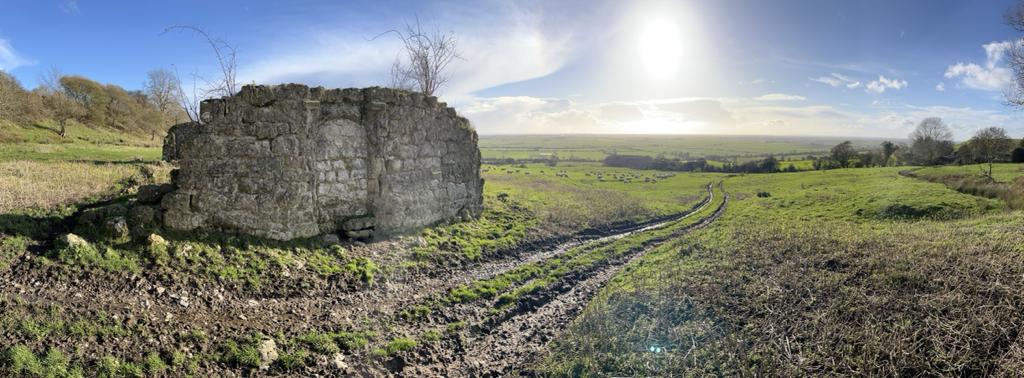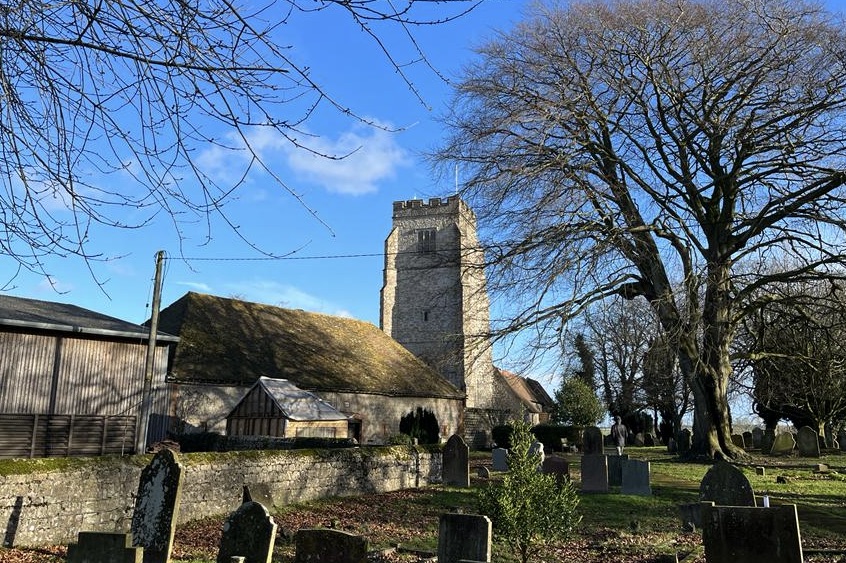Hidden down a muddy farm track on the greensand ridge overlooking Romney Marsh is a ruined chapel and the site of a 16th century miracle – allegedly.
It was here in 1526 that Elizabeth Barton, a 20-year-old servant girl from the nearby village of Aldington, prophesised that she would be cured of the seizures and deathlike trances that had recently afflicted her. She had growing a reputation among the local population for the visions and prophesies that emerged during her trances, so a considerable crowd reportedly gathered to watch the event.

Elizabeth Barton’s chapel looking towards Dungeness. Photograph Aris Chan.
Sure enough, she was cured of her illness, which was probably a form of epilepsy, but she continued to have visions and make prophesies and pronouncements on the importance of traditional virtues such as pilgrimage, attending mass and confession.
As Barton’s fame grew, the church worthies in Canterbury who were loyal to Rome saw her as a useful propaganda tool to counter the Reformation that sweeping northern Europe. They sought to control her message by bringing her inside the fold and installing her at St Sepulchre’s Nunnery, just outside Canterbury’s city wall by today’s Nunnery Fields. At their behest, she went out on speaking tours and reportedly drew crowds in their thousands.
Then her prophesies took a dangerous turn. She had a vision that God was displeased with King Henry VIII’s plan to divorce his first wife, Catherine of Aragon and marry Anne Boleyn. If the King went ahead with the marriage, she warned, he would die within a month and England would be beset by plague.
The archbishop of Canterbury arranged an audience for Barton with the king, and Henry was apparently troubled enough by her prophesy to put his divorce plans on hold for a while. But when Anne Boleyn became pregnant, Henry was forced to act. In May 1533, the new Archbishop of Canterbury, and staunch ally of the king, Thomas Cranmer declared Henry’s marriage to Catherine null and void, and, on 1 June, Anne was crowned queen consort.
In the meantime, Barton had continued to make public pronouncements and her word had been widely disseminated with the help of clerics opposed to the divorce, principally, a monk at Christchurch Priory named Edward Bocking, who published a book of Barton’s prophesies in the summer of 1533.
By September 1533, however, it was clear that Barton’s prophesy had failed and the authorities were emboldened enough to take extreme measures that would silence all critics of the king for good. Bocking was arrested, all copies of his book were destroyed, and Barton was taken in for questioning and/or torture by Archbishop Cranmer. Barton allegedly confessed that she never had any visions and that her prophesies were all concocted to please the crowd and attain worldly fame. She was forced to publicly recant all her prophesies and in January 1534, Barton, Bocking and several other alleged co-conspirators were charged by parliament with treason and sentenced to death.
On 20 April, Barton and the others were taken from their cells in the Tower of London and dragged through the muddy streets to the execution ground at Tyburn, near today’s Marble Arch. Barton was hanged and then decapitated. Her head was boiled, placed on a spike and displayed for all to see on London Bridge. She remains the only woman ever to be awarded that particular distinction. Before her death, Barton reportedly told the assembled crowd:
I have not only been the cause of my own death, which most justly I have deserved, but also, I am the cause of the death of all these persons which at this time here suffer. And yet, to say the truth, I am not so much to be blamed considering it was well known unto these learned men that I was a poor wench without learning – and therefore they might have easily perceived that the things that were done by me could not proceed in no such sort, but their capacities and learning could right well judge from whence they proceeded… But because the things which I feigned was profitable unto them, therefore they much praised me… and that it was the Holy Ghost and not I that did them. And then I, being puffed up with their praises, feel into a certain pride and foolish fantasy with myself.
We will probably never know for sure if Barton was simply a “poor wench” manipulated by “learned men” for their own devices or someone with more agency who was determined to speak the truth as she saw it, right up to the point where it was futile to continue. I like to think the 28-year-old Elizabeth Barton knew exactly what she was doing, and that her gallows speech was a last dig at the men who thought they could control her.
Barton is known in the historical record as the “Holy Maid of Kent” but the Catholic church never fully embraced her. There may have been too many doubts about the authenticity of her visions or maybe the church decided it was not in its interest to formally designate this “poor wench” as a martyr to the cause of the true faith – she was, after all, no Joan of Arc. Whatever the reason, very few people in Kent today are aware of their Holy Maid.

St Martin’s Church in Aldington. Photograph Aris Chan
Nowadays, just about the only visitors to the site of Barton’s miracle are grazing sheep, and even at the nearby St Martin’s church in Aldington where Barton reportedly prayed, the current custodians had no idea who she was or what she did. There are several locations in Canterbury that bear the Barton name, including Barton Court Grammar School, adjacent to St Augustine’s Abbey, but these places have nothing to do with Elizabeth. Barton, in this case, is simply another name for the domain that was directly controlled by a medieval lord of the manor – possibly derived from Bar Ton, meaning an enclosure of barley.
I think Elizabeth Barton deserves better. Perhaps one day, the students at Barton Grammar School and others will really get to know their school’s namesake, and appreciate the story of the Holy Maid of Kent.
One thought on “Shooting the Messenger: The revelations and execution of Elizabeth Barton, Holy Maid of Kent”
Comments are closed.